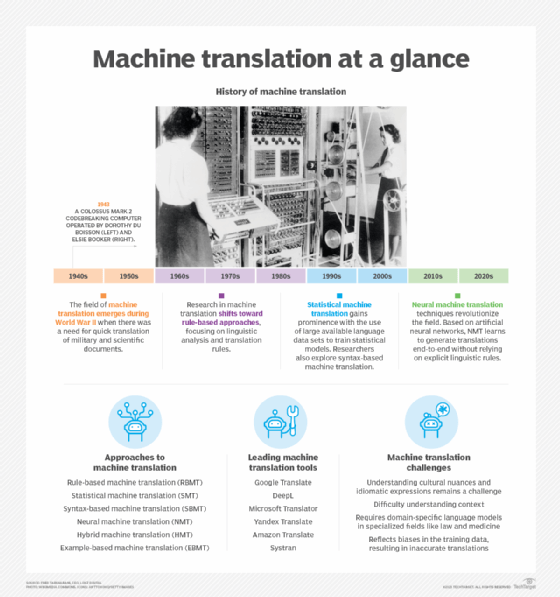
What is machine translation?
Machine translation technology enables the conversion of text or speech from one language to another using computer algorithms.
In fields such as marketing or technology, machine translation enables website localization, enabling businesses to reach wider clientele by translating their websites into multiple languages. Furthermore, it facilitates multilingual customer support, enabling efficient communication between businesses and their international customers. Machine translation is used in language learning platforms to provide learners with translations in real time and improve their understanding of foreign languages. Additionally, these translation services have made it easier for people to communicate across language barriers.
How does machine translation work?
Machine translation works by using advanced algorithms and machine learning models to automatically translate text or speech from one language to another. Here's how it generally happens:
1. First, the input text or speech is prepared via filtering, cleaning and organizing.
2. Then, the machine translation system is trained using examples of texts in multiple languages and their respective translations.
3. The system learns and analyzes examples to understand patterns and probabilities of how words or phrases are translated.
4. When a new text to translate is inputted, the system uses what it has learned to generate the translated version.
5. After generating the translation, some additional adjustments may be added to refine the results.
Different approaches to machine translation
Here are some common approaches machine translation uses to translate one text or language into another.
1. Rule-based machine translation (RBMT). In rule-based machine translation, linguistic rules and dictionaries are used to generate translations based on established language rules and structures. These rules define how words and phrases in the source language should be transformed into the target language. RBMT requires human experts to create and maintain these rules, which can be time-consuming and challenging. It often performs better for languages with well-defined grammatical rules and less ambiguity and metaphors.
Example: A rule-based translation system might have a rule stating that the word "dog" in English should be translated to "perro" in Spanish.
2. Statistical machine translation (SMT). Statistical machine translation involves analyzing vast amounts of bilingual texts to identify patterns and probabilities for accurate translation. Instead of relying on linguistic rules, SMT uses statistical models to determine the most likely translations based on patterns observed in the training data. It aligns source and target language segments to learn translation patterns. SMT works well with larger training data and can handle diverse language pairs.
Example: In SMT, the system might learn that "cat" often appears in the same context as "gato" in parallel bilingual texts, leading to the translation of "cat" as "gato."
3. Syntax-based machine translation (SBMT). Syntax-based machine translation takes into account the syntactic structure of sentences to improve translation accuracy. It analyzes the grammatical structure of the source sentence and generates a corresponding structure in the target language. SBMT can capture more complex relationships between words and phrases, allowing for more accurate translations. However, it requires sophisticated parsing techniques and can be computationally expensive.
Example: SBMT learns the syntactic structure of a sentence and ensures that the subject and verb agreement is maintained in the translation for a more grammatically accurate output.
4. Neural machine translation (NMT). Neural machine translation utilizes deep learning models, particularly sequence-to-sequence models or transformer models, to learn translation patterns from training data. NMT learns to generate translations by processing the entire sentence, considering the context and dependencies between words. It has demonstrated significant improvements in translation quality and fluency. NMT can handle long-range dependencies and produce more natural-sounding translations.
Example: NMT takes an input sentence like "The cat is sleeping" and generates a translation like "El gato está durmiendo" in Spanish, capturing the context and idiomatic expression accurately.
5. Hybrid machine translation (HMT). Hybrid machine translation may incorporate rule-based, statistical and neural components to enhance translation quality. For example, a hybrid system might use rule-based methods for handling specific linguistic phenomena, statistical models for general translation patterns, and neural models for generating fluent and contextually aware translations.
Example: A hybrid system could use a rule-based approach for handling grammatical rules, statistical models for common phrases, and a neural model to generate fluent translations with improved context understanding.
6. Example-based machine translation (EBMT). Example-based machine translation relies on a database of previously translated sentences or phrases to generate translations. It searches for similar examples in the database and retrieves the most relevant translations. EBMT is useful when dealing with specific domains or highly repetitive texts but may struggle with unseen or creative language usage.
Example: If the sentence, "The cat is playing," has been previously translated as "El gato está jugando," EBMT can retrieve that translation as a reference to translate a new sentence, "The cat is eating."

History and evolution of machine translation
The history and evolution of machine translation (MT) can be traced back to the mid-20th century when researchers began exploring the idea of automating the translation process. Here is an overview of the major milestones in the history of machine translation:
1940s-1950s. The field of machine translation emerged during World War II when there was a need for quick translation of military and scientific documents. Researchers like Warren Weaver and Yehoshua Bar-Hillel proposed the idea of using computers to automate translation. Early systems, such as the Georgetown-IBM Experiment, were rule-based and relied on handcrafted linguistic rules.
1960s-1980s. In the 1960s and 1970s, research in machine translation shifted toward rule-based approaches. Systems like SYSTRAN and METEO developed during this period, focusing on linguistic analysis and translation rules. However, rule-based systems faced challenges in handling complex linguistic phenomena and required extensive manual effort to develop and maintain the rule sets.
1990s-2000s. In the 1990s, SMT gained prominence as developers used large available language data sets to train statistical models that could capture words, phrase alignments and probabilities. SMT achieved better translation quality by using the statistical properties of the training data.
1990s-2000s. Researchers also explored syntax-based machine translation during the same period. SBMT systems incorporated syntactic analysis to guide the translation process. Syntax-based approaches try to address the limitations of purely statistical methods in handling language syntax.
2010s-present. The introduction of neural machine translation (NMT) in the 2010s revolutionized the field. NMT models, based on artificial neural networks, transformed the translation process by learning to generate translations end-to-end without relying on explicit linguistic rules. Systems like Google Translate, OpenAI's GPT-3 and Facebook's Fairseq have demonstrated significant improvements in translation quality and fluency.
Hybrid approaches, which emerged around the turn of the 20th century and continue to evolve, integrated rule-based, statistical and neural approaches to achieve better translation quality. The hybridization aimed to combine the advantages of each technique and address their individual limitations.
Alongside advancements in machine translation technology, post-editing and computer-assisted translation tools play an important role in the translation process. Post-editing involves human translators editing and refining machine-generated translations. Computer-assisted translation tools are used to assist human translators in the process by providing features such as machine translation memory, terminology management, real-time suggestions and formatting support.
Machine translation use cases and benefits
Machine translation can bring benefits to many different industries.
- Travel and tourism. Using machine translation technology, individuals can easily communicate when traveling to a foreign country without the need of human translators.
- E-commerce and international business. Machine translation can help online businesses reach customers on a global scale. It automatically translates product descriptions, reviews and even customer support, making it easier for people to understand and buy merchandise. It also helps adapt software, websites and marketing content to different languages and cultures, connecting with people all over the world.
- Media and publishing. News articles, blogs and other written content can reach a global audience thanks to machine translation. It makes it quick and easy to translate and distribute information, breaking down language barriers and facilitating better interaction with readers.
- Customer support and service. Machine translation instantly translates conversations with customers, whether it's over the phone or through online chats, enhancing the support experience.
- Healthcare and medical research. Machine translation is critical in translating medical documents, research papers and patient records across different languages. It brings together researchers and healthcare professionals from all over the world, improving collaboration and access to information.
Notable issues with machine translation
Machine translation isn't perfect and requires adjustments and refining, especially when it comes to accuracy, cultural nuances, idiomatic expressions and subjective content.
Machine learning systems still have trouble understanding context. Professional translators may need to step in to ensure accuracy and precision of translations, adding to the cost of machine translation.
For specialized fields, such as law and medicine, machine translation needs access to domain-specific models and language models to be accurate.
In addition, machine translation technology can reflect gender and cultural biases in the training data, resulting in flawed translations. It also has trouble handling rare languages, due to a lack of sufficient training data.
But the technology's limitations will diminish, alongside advancements in machine learning and natural language processing. Machine translation remains an active area of research, with ongoing efforts to address the aforementioned challenges and improve translation quality.
Leading machine translation tools and technology
It is important to understand the specific use case for machine translation before choosing a tool. Here are a variety of popular tools that can be customized and used for different use cases:
- Google Translate is the most popular machine translation tool available. It is free to use and supports over 100 languages. Google Translate uses an NMT model to translate text, which means that it can learn from large amounts of data to improve its accuracy.
- DeepL is another popular machine translation tool that is known for its accuracy. It supports over 26 languages and uses an NMT model that is trained on a massive data set of text and code. DeepL is a paid tool, but it offers a free trial.
- Microsoft Translator is a free machine translation tool that supports over 60 languages. It uses an SMT model, which means that it relies on statistical data to translate text. Microsoft Translator is a good option for simple translations, but it may not be as accurate as NMT-based tools.
- Yandex Translate is a free machine translation tool that supports over 90 languages. It uses a NMT model that is trained on a massive data set of text and code. Yandex Translate is a good option for general-purpose translations, but it may not be as accurate as some other tools for specific languages or domains.
- Amazon Translate is a paid machine translation service that supports over 200 languages. It uses an NMT model that is trained on a massive data set of text and code. Amazon Translate is a good option for businesses that need to translate large amounts of text or that need to customize their translations.
- Systran, founded 55 years ago, provides machine translation software that employs hybrid machine translation technology. It combines rule-based and neural machine translation approaches to deliver precise translations with customizable industry-specific solutions.
Best practices for using machine translation tools
Following these four best practices will help you get the most out of your machine translation tools and produce high-quality translations.
1. Identify your goals. What do you want to achieve with machine translation? Are you translating for general understanding, or do you need a more accurate translation for a specific purpose, such as incorporating MT into your models?
2. Consider the input format. Some machine translation tools are better suited for certain types of text than others. For example, Google Translate is good for translating short, simple sentences, while DeepL is better for translating longer, more complex texts. Remember to choose the right tool for your use case.
3. Optimize the input. The quality of the output from machine translation can be improved by optimizing the input. This means formatting the text correctly, removing any errors and providing context where possible.
4. Post-edit the output. Even the best machine translation tools can produce output that needs to be post-edited by a human translator; however, there are automated editing tools that can manage this. This is especially true for sensitive or technical content.







